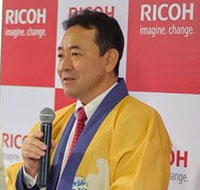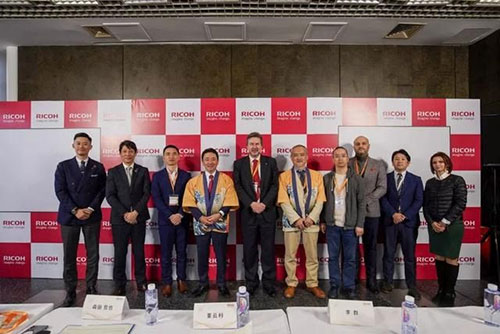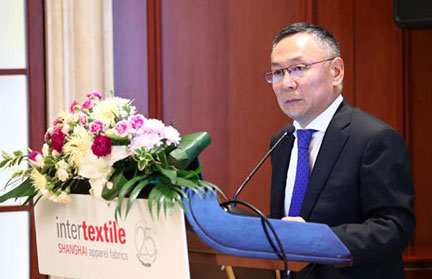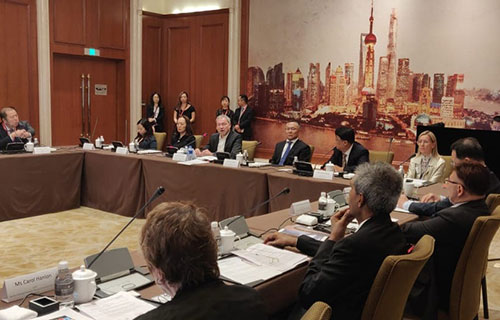FW
Azerbaijan recorded a cotton harvest of 293,880 tonne according to the agriculture ministry, which is a 31.9 per cent increase over the figures during same period last year, when production was 222,748 tonne. This is the result of the agrarian reforms, include measures to increase cotton harvesting, carried out in the country.
Cotton production in the country is most developed in Saatli, Bilasuvar, Barda, Aghjabadi and Sabirabad regions.
The country’s State Program for 2017-2022, approved in early 2017, aims at strengthening measures to develop cotton growing, increase export potential in the field, ensure employment of the rural population and increase cotton production.The new goal of the government is to boost cotton production to 500,000 tonnes by 2022 from the current 260,000 tonnes.
There are 23 cotton processing plants, seven yarn factories and three cotton oil enterprises in Azerbaijan.
"RICOH shared its Digital Micro Factory (DMF) concept workflow at the 19th International Textile Industry Exhibition (ShanghaiTex 2019), held from November 25-28 at the Shanghai Expo Center. Ramp up-RICOH’s partnership by Universal Platform was officially launched at the M2 Conference Hall on Nov 26 with a ceremony and press conference marking the new alliance and its fashion manufacturers"
 RICOH shared its Digital Micro Factory (DMF) concept workflow at the 19th International Textile Industry Exhibition (ShanghaiTex 2019), held from November 25-28 at the Shanghai Expo Center. Ramp up-RICOH’s partnership by Universal Platform was officially launched at the M2 Conference Hall on Nov 26 with a ceremony and press conference marking the new alliance and its fashion manufacturers. Tetsuya Morita, Corporate Vice President of Ricoh Co and General Manager of Industrial Printing, Koji Miyao, Chairman and General Manager of Ricoh China Co and others of the Ricoh Group maintained a unified presence throughout the exhibition and conference.
RICOH shared its Digital Micro Factory (DMF) concept workflow at the 19th International Textile Industry Exhibition (ShanghaiTex 2019), held from November 25-28 at the Shanghai Expo Center. Ramp up-RICOH’s partnership by Universal Platform was officially launched at the M2 Conference Hall on Nov 26 with a ceremony and press conference marking the new alliance and its fashion manufacturers. Tetsuya Morita, Corporate Vice President of Ricoh Co and General Manager of Industrial Printing, Koji Miyao, Chairman and General Manager of Ricoh China Co and others of the Ricoh Group maintained a unified presence throughout the exhibition and conference.
Koji Miyao said Ricoh aims to expand its China business into a core market, as Europe and the Americas, following impetus from this year's China International Import Expo and 83 years of comprehensive market deployment. The Ricoh Group would continue to develop technologies and experience in Commercial Printing, but incorporating sustainable development and opening greater possibilities in Industrial Printing, with comprehensive and new, innovative technologies.
Tetsuya Morita, General Manager of Industrial Printing, announced that digital micro-factory DMF, a very important concept to the Group, and RAMP-UP the apparel consortium had officially launched, answering to social issues in the future such as environmentalism and safety within the apparel ecosystem. Ricoh would strive to create an open global business environment, so as to push forward social problems such as water pollution, electricity consumption and excess inventory, maintaining a comfortable and safe living environment, a common issue for all human beings.
Morita elaborated the proof of concept and the positive steps to be taken in testing from the first and second quarter 2020, with details on the company's website. His next remarks were given to the Ricoh Group's unremitting contribution to achieving sustainable development goals (SDGs) advocated by the United Nations, and to the role the DMF digital micro-factory so vigorously launched will play in solving various social problems and providing new customer value to more and more people in the garment and related markets.
Three additional companies including Hangzhou Dianshi Clothing Co also confirmed joining the consortium, while many companies were in the process of joining the consortium as well.
Morita acknowledged the highly developed nature of the Chinese apparel industry, but suggested the DMF concept was for the world market, including China. Ricoh hopes to expand sales of DMF workflow cloud solutions and textile printers, with a goal of JPY10 billion in revenue by the year 2025. DMF will produce significant social benefits using the advantages of industrial inkjet technology, such as diversity, customization, differentiation, multi-type small lot production and leading the industry trend.
Stepping up efforts to deploy the DMF concept itself, Ricoh entered a collaboration with Sweden's Coloreel (March 2019) to develop an on-demand thread dye and inkjet printer. Ricoh also acquired LAC Corporation (2018, renamed Ricoh Digital Painting Company, Ltd.) and ColorGate Digital Output Solutions GmbH, (2018) a leading software provider with strength in color management. The ColorGate acquisition marked an important first step in active capital cooperation, eliminating self-efficiency, and permitting Ricoh to RAMP-UP its partnership programs.
"The Chinese textile industry has become a key player after decades of reform. In 2018, Chinese production of chemical fibers made up over two thirds of the global production. “Textile exports from the country also increased by 3.5 per cent to reach 37.6 per cent of the world’s total in 2018, while apparel exports accounted for 31.3 per cent of the total world’s total exports"
 Advanced manufacturing and additional investments in companies across the world, have made China the world’s biggest textile market. To exploit the growing potential of this market, the 25th Autumn Edition of Intertextile Shanghai Apparel Fabrics organised a private round table meeting on September 25, 2019. The conference included a keynote speech and a panel discussion. Olaf Schmidt, Vice President of Textiles & Technologies at Messe Frankfurt delivered the welcome speech. “Through this fair, we aim to curate a fringe programme that will inform, engage and connect thought leaders from across the world,” he said.
Advanced manufacturing and additional investments in companies across the world, have made China the world’s biggest textile market. To exploit the growing potential of this market, the 25th Autumn Edition of Intertextile Shanghai Apparel Fabrics organised a private round table meeting on September 25, 2019. The conference included a keynote speech and a panel discussion. Olaf Schmidt, Vice President of Textiles & Technologies at Messe Frankfurt delivered the welcome speech. “Through this fair, we aim to curate a fringe programme that will inform, engage and connect thought leaders from across the world,” he said.
Xu Yingxin, Vice President of the China National Textile and Apparel Council and Chairman of CCPIT-TEX (co-organiser of the fair) delivered the keynote address, titled: The Current Situation of China’s Textile Industry. The main takeaways from the keynote address and the panel discussion were:
High demand from the domestic market
The Chinese textile industry has become a key player after decades of reform. In 2018, Chinese production of chemical fibers made up over two thirds of the global production. “Textile exports from the country also increased by 3.5 per cent to reach 37.6 per cent of the world’s total in 2018, while apparel exports accounted for 31.3 per cent of the total world’s total exports,” noted Yingxin 
Although the purchasing power of Chinese consumers has slowed slightly, country’s textile industry is still experiencing high demand from the domestic market. “Our huge population offers our apparel industry a huge safety net as clothing is a necessity rather than a luxury,” Yingxin observed. However, though apparel sales have continued to grow in 2019, the pace of growth slowed.
Emphasis on creating a strong consumer economy
The panel discussion also focused the importance of a strong consumer economy in order to maintain high domestic purchasing power. Paul Alger, UK Fashion & Textile Association warned of the social consequences and lack of purchasing power caused due to a weak consumer economy. KV Srinivasan, TEXPROCIL indicated that India’s consumer economy benefits from their strength, including a rich textile heritage and skilled technical workforce.
Three missions to develop the textile industry
China’s textile investments in 2019 focused on technology and innovation, resulting in increased productivity. The Autumn edition of Intertextile Shanghai Apparel Fabrics noted three key missions for China’s progress including technology and innovation; culture and local talent; and sustainability.
The panel discussion further focused on sustainability. Carol Hanlon, Textile Clothing Footwear Resource Centre, Australia pointed out “As a leader of textile production, China has the capacity to drive change in circularity. There will be a demand for sustainability in the future as younger generations are increasingly associated with climate activism.”
Burgeoning investments strengthen manufacturing, increase co-operation
During the first five years of the Belt & Road initiative, total trade volume between China and other countries along the Belt & Road route exceeded $6 trillion, accounting for nearly a third of China’s total trade in goods during this period. By 2018, the country reportedly invested $6.5 billion in countries along the Belt & Road route. These investments offer a two-fold benefit to China. They build efficient manufacturing bases along the Belt & Road route besides increasing international co-operation to strengthen resources throughout the supply chain.
China creating opportunities for other countries
China exports around 18 per cent its textiles to the US. It is also the largest exporter of textiles and apparel to the US, accounting for 38 per cent of the nation’s total imports. This is creating new opportunities for other countries to explore the US market. Ade Sudrajat, Indonesian Textile Association noted, “We aim to develop our local e-commerce and start-ups.”
Autumn 2019 Edition of Intertextile Shanghai Apparel Fabrics was held from September 25-27, 2019 in Shanghai. The event was co-organised by Messe Frankfurt (HK) alongwith Sub-Council of Textile Industry, CCPIT; and the China Textile Information Centre.
Japanese company Nippon Koei plans to invest in the Cambodian silk industry. This investment will improve the domestic silk market which is currently facing competition from increasing imports.
The Cambodian silk sector currently faces challenges such aslack of raw materials, human resources and financial resources. Secondly, handmade Cambodian silk cannot compete with low cost imported silk products.
The country imports silk and cotton yarn from China, Vietnam and Thailand due to the lack of locally produced raw materials. As the National Silk Strategy Report 2016-2020 reveals, the country’s silk yarn production accounts for only one per cent of total domestic consumption, while its imports accountfor 99 per cent – equivalent to more than 400 tonne per year. This imported silk can be used to make a wide range of products such as ties, clothing, bags, and items for home decor, hotels, shops and others.
The Smart Myanmar project launched by the EU aims at improving social and environmental performance at more than 100 garment and textile factories across the country.
With support from engineers and local and European experts, the project will deliver on-site assessments and training on topics such as human resource management systems and workplace communications, occupational safety and health, chemicals and waste management, and energy efficiency. The aim is to foster decent work conditions and responsible business practices in Myanmar. The initiative has carried out training and consultancy programs with 299 garment, textile and footwear factories since 2016, implementing thousands of improvements related to safe workplaces, effective HR management and energy efficiency. Now the focus is on further strengthening sustainable production practices and responsible supply chains in Myanmar and Europe.
Since 2013, Myanmar’s garment sector has witnessed a staggering export-oriented growth. The garment industry has served largely the European market and created job opportunities for thousands, mostly women. Europe is one of the world’s largest consumer markets and European consumers pay a lot of attention where the products they buy come from and how they are produced. Sustainable production and respect for international labor standards are therefore important topics in the EU’s trade relations with Myanmar.
The US government has strengthened labor, environmental, pharmaceutical and enforcement provisions in the US-Mexico-Canada Agreement (USMCA), setting the stage for its passage. The new USMCA includes several improvements that would greatly benefit the U.S. textile industry and bolster the $20 billion in annual trilateral textile and apparel trade.
The key updates and modifications that USMCA makes over NAFTA include creation of a separate chapter for textiles and apparel rules of origin with strong customs enforcement language, and stronger rules of origin for sewing thread, pocketing, narrow elastics and certain coated fabrics.
Under the current NAFTA, these items can be sourced from outside the region. USMCA fixes this loophole and ensures these secondary components are originating to the region.
In addition, USMCA fixes the Kissell Amendment Buy American loophole, ensuring that a significant amount the Department of Homeland Security spends annually on clothing and textiles for the Transportation Security Administration benefits domestically produced products.
Panda Biotech, based in the US, is developing its first industrial hemp processing facility to produce high-quality, textile-grade fiber and premium cellulose. The facility is expected to be the largest hemp decortication center in the United States and one of the largest in the world. Panda Biotech will deploy the most technologically advanced, highest capacity and first-of-its-kind industrial hemp decorticating equipment ever used to separate the fiber and cellulose from the stalk. To ensure the highest quality fiber, the company will only process hemp stalks that are harvested prior to the maturation of the seed and the flower. Panda Biotech is a first-mover in the emerging US industrial hemp fiber and cellulose industry. The company is currently developing industrial hemp processing facilities.
Processing of the hemp stalk for industrial uses is expected to be the next multi-billion-dollar business in the United States. Hemp fiber and cellulose can help manufacturers meet the needs of today’s eco-conscious consumers who increasingly require environmentally friendly products and services. Hemp is seen as a game changer for both agriculture and industry for generations to come. Processed fiber and cellulose from industrial hemp can be used in the production of a multitude of products including textiles.
During 2018-19, Burberry reduced its market-based emissions by 43 per cent. In the same period, the brand procured 58 per cent of its total energy (including 68 per cent of its electricity) from renewable sources. Burberry is now carbon neutral across the Americas region, its EMEIA retail stores and UK operations and aims at being 100 per cent carbon neutral by 2022. It has set two new, ambitious climate goals approved by the Science Based Target initiative for its own operations and extended supply chain. Burberry has partnered with UN Climate Change to launch the UN Fashion Industry Charter for Climate Action in 2018. The charter aims to drive change across the fashion industry with an initial goal of reducing aggregate greenhouse gas emissions by 30 per cent by 2030. Aligned with the goals of the Paris Agreement, the charter is looking at how fashion can address climate change, from reducing carbon impacts at production stage, selecting climate friendly and sustainable materials to exploring circular business models, improving consumer dialogue and awareness and working with policymakers to catalyse scalable solutions.
Burberry intends for every single product it sells to have at least one positive attribute by 2022. Some products might be made out of an environmentally-friendly material, like its newly introduced Econyl made from recycled fishing nets. Others might use traditional materials, but they are manufactured at a carbon-neutral factory.
From April to September 2019 exports of readymade garments from India increased by just 2.2 per cent. Indian exports are not competitive. Textiles from India are around 10 per cent costlier than textiles from other countries. Also Bangladesh, Sri Lanka and Vietnam have low production costs and their exporters enjoy preferential duty access to key markets. In comparison Indian exporters face higher trade barriers in the US and the European Union. Bangladesh’s exports to the EU face zero per cent tariff and exports to the US face 3.9 per cent tariff. Indian textile exports face six per cent tariff in the EU and 6.2 per cent tariff in the US.
In an attempt to counter subdued exports, Indian readymade garment exporters are creating modalities to make a portal or a central database, where they can list their products according to categories to assist buyers. Buyers will be able to reach out to potential exporters easily through this mechanism. The software will send mailers/alerts to all exporters who produce such items and also to the importer; this would happen when an importer searches for a certain product. This is expected to increase buyer-seller interface and hence help exporters as well as importers.
Gujarat’s cotton production may fall by 10 to 15 per cent. The main reason is unseasonal rains coupled with the menace of pink bollworm, an insect known for being a pest in cotton farming. Due to the unseasonal rains, the cotton crop is affected by higher moisture. As a result, farmers are selling their yield in the open market at relatively lower prices. Against the minimum support price of Rs 5550 a quintal, farmers are earning around Rs 4000 to Rs 5000 per quintal in the open market.
Gujarat accounts for almost 30 per cent of the total cotton production in the country. This ratio is expected to be maintained despite the adverse conditions as the sowing area of cotton in the state has gone up from 23 lakh hectares in the last season to over 26 lakh hectares.
At one time South Indian textile mills reduced their cotton procurement by around 40 per cent from Gujarat. The reason was increased adulteration in cotton. Faced with a growing demand, ginners in Gujarat reportedly started mixing comber waste in the cotton. This propelled many mill owners to tap other parts of the country for cotton procurement to meet the compliance norms set by buyers.












